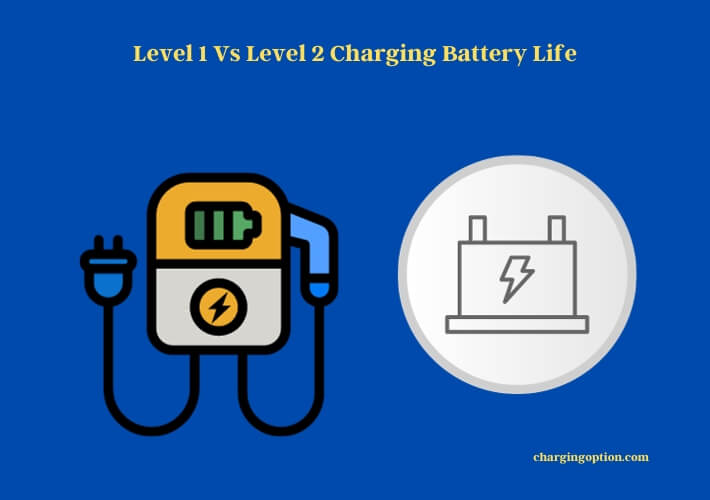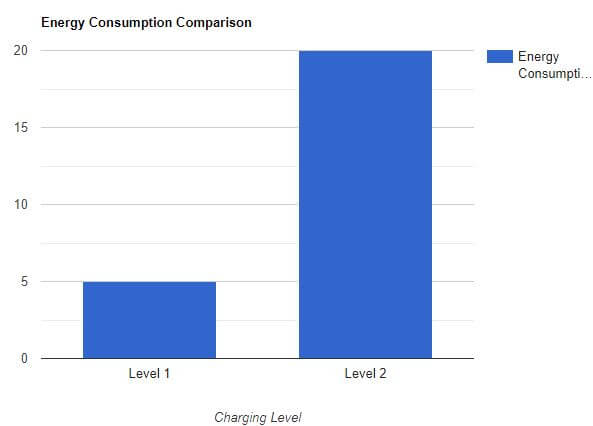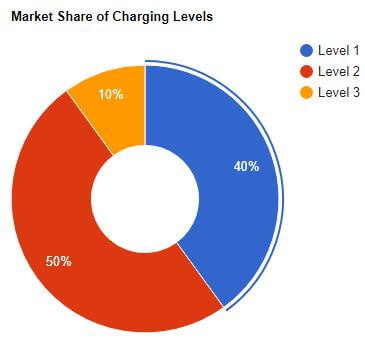Level 1 and Level 2 chargers differ significantly in their charging speeds and their impact on battery life. The choice between them often hinges on individual needs and the intended application.
Level 1 chargers are the basic option, offering a charging speed that provides about 4 miles of driving range per hour. This makes them suitable for overnight charging or for vehicles that aren’t used frequently. On the other hand, Level 2 chargers are more advanced and can offer an average of 32 miles of driving range per hour of charge. This makes them a preferred choice for daily drivers or those who need a quicker charge.
In terms of costs, Level 1 charging is generally less expensive due to its slower speed and simpler infrastructure. Level 2 charging, while faster, might come with a higher initial cost, especially if one is considering installing a Level 2 charger at home. Yet, the convenience it offers in terms of speed can often justify the investment.

Beyond these two, there’s also Level 3 charging, which is even faster but is typically found in commercial settings rather than residential ones. For those considering home installations, Level 2 charging stations are the most common. They provide a good balance between speed and efficiency, delivering a notable amount of kWh per hour.
In summary, while Level 1 chargers are slower and more cost-effective, Level 2 chargers offer a faster charging speed, making them ideal for frequent drivers. The choice between them should be based on individual driving habits and charging needs.
Basics of Electric Vehicle Charging
Differentiating between Level 1 and Level 2 Chargers
Electric vehicle owners often find themselves at a crossroads, choosing between Level 1 and Level 2 chargers. Level 1 chargers are essentially your standard household plugs, convenient and requiring no additional installation. They’re the go-to for overnight charging, ensuring your car is ready to roll by morning. Level 2 chargers, on the flip side, are the middle ground in the charging spectrum, offering faster charging speeds and are often found in public charging stations or can be installed at home for quicker, more efficient charging.
The Technology Behind Each Charging Level
Level 1 chargers are straightforward, utilizing a 120V AC plug and a standard electrical outlet. It’s the simplicity and accessibility that make them a common choice for EV owners. Level 2 chargers step it up a notch, operating at 240V and often requiring a dedicated circuit. The enhanced power output translates to faster charging times, a feature that’s making them increasingly popular among the electric vehicle community.
Charging Speeds and Driving Range
How Charging Speeds Translate to Driving Range
The correlation between charging speeds and driving range is direct and significant. With Level 1, patience is a virtue, as the slower charging speed offers a modest boost to your driving range. It’s a stark contrast to Level 2 chargers, which inject life into your EV at a much brisker pace, amplifying the driving range and making long-distance travel more feasible.
Factors Affecting the Efficiency of Each Charging Level
Numerous elements come into play in determining the efficiency of Level 1 and Level 2 chargers. The vehicle’s onboard charging capacity, the charger’s output capability, and even external factors like temperature can influence charging efficiency. It’s a delicate dance of variables, each playing a pivotal role in how quickly an EV owner can hit the road with a fully charged battery.
Cost Implications
Initial Setup and Installation Costs
The financial aspect of EV charging can’t be overlooked. Level 1 chargers are cost-friendly, with minimal setup requirements. In contrast, Level 2 chargers might have you reaching deeper into your pockets initially, thanks to the need for specialized installation. Yet, many find this a worthy investment for the convenience and speed it brings to the table.
Long-term Cost Benefits and Drawbacks
While the upfront costs are a factor, the long-term financial implications are equally crucial. Level 1 chargers, though inexpensive initially, lead to longer charging times and could potentially mean higher electricity costs over time. Level 2, with its efficiency, can be a cost-saver in the long run, reducing the charging time and, consequently, electricity costs.
Impact on Battery Life
How Each Charging Level Affects Battery Longevity
The narrative around battery life is nuanced. Level 1’s slower charging pace is gentle on the battery, potentially extending its lifespan. Level 2, with its rapid charging capability, might raise concerns about long-term battery wear, but modern EVs are equipped with systems to mitigate these effects, balancing speed and battery preservation.
Factors Contributing to Battery Wear and Tear
Environmental conditions, usage patterns, and even the vehicle’s make and model influence battery degradation. It’s not just about the charger but a holistic view of the entire ecosystem influencing battery health. Each charging session is a chapter in the ongoing story of the battery’s life, with multiple factors scripting its longevity narrative.
Comparison of Battery Degradation Over Time for Level 1 and Level 2 Charging
| Years | Level 1 Battery Degradation (%) | Level 2 Battery Degradation (%) |
|---|---|---|
| 1 | 2 | 3 |
| 2 | 4 | 7 |
| 3 | 7 | 12 |
Home Charging Dynamics
Setting up Level 1 and Level 2 Chargers at Home
The home charging landscape is diverse, with options catering to varied needs. Level 1 is the plug-and-play variant, no frills, no fuss. It’s about simplicity and accessibility. Level 2, though requiring a bit more in terms of installation, brings the public charging station experience to your doorstep, a blend of speed and convenience that’s hard to ignore.
Safety and Maintenance Considerations
Safety and maintenance are integral to the home charging conversation. Both Level 1 and Level 2 chargers are designed with safety protocols, but awareness and adherence to guidelines are paramount. Maintenance, though minimal, is essential to ensure optimal performance and longevity, making the charging experience seamless and reliable.
Environmental Implications
Energy Consumption of Each Charging Level
Every charge leaves a footprint. Level 1, with its slower pace, is often seen as the more energy-conservative option. Level 2, though faster, raises questions about energy consumption and efficiency. It’s a dialogue that extends beyond the charger, roping in factors like energy sources and consumption patterns.
Carbon Footprint Comparison
The environmental conversation isn’t complete without addressing the carbon footprint. Both Level 1 and Level 2 have their narratives, influenced by factors like energy source, efficiency, and even the vehicle’s consumption patterns. It’s a complex, multifaceted dialogue that shapes the environmental impact narrative of EV charging.
Energy Consumption of Level 1 vs. Level 2 Charging

Advanced Charging Options Beyond Level 1 and 2
Brief Overview of Level 3 and Other Advanced Charging Options
As the EV landscape evolves, so do charging options. Level 3 and other advanced chargers are entering the scene, offering unprecedented charging speeds. They’re rewriting the charging narrative, offering solutions that cater to the needs of a diverse, dynamic, and growing community of EV enthusiasts.
How They Compare in Terms of Speed, Cost, and Battery Impact
Speed, cost, and battery impact are the pillars that define the Level 3 and advanced charging narrative. They’re not just about speed but a balanced approach that considers the financial and battery health implications. It’s a narrative of evolution, innovation, and a glimpse into the future of EV charging.
Market Share of Different Charging Levels

Making the Right Choice for Your Needs
Assessing Individual Driving Habits
Your driving habits are the compass guiding your charging choices. Are you a city dweller with short commutes or someone who frequently embarks on long drives? Your driving patterns shape your charging needs, making it essential to evaluate and align them with the right charging solution.
Evaluating the Pros and Cons of Each Charging Level
Every charging level has its story, a blend of pros and cons that cater to varied needs. It’s about weighing these factors, understanding the nuances, and making an informed choice. It’s not a one-size-fits-all narrative but a tailored approach that resonates with individual needs and preferences.
Visualization of Charging Infrastructure Growth Over the Years
100 Stations
200 Stations
400 Stations
800 Stations
1600 Stations
FAQs
What’s the Core Difference Between Level 1 and Level 2 Charging?
Level 1 charging uses a standard 120V AC household outlet, making it the most accessible and straightforward option for many electric vehicle (EV) owners. It’s akin to charging your smartphone at home. On the other hand, Level 2 charging operates at 240V AC, similar to what large appliances like ovens or dryers use. This increased voltage allows for faster charging speeds, making it a popular choice for those who drive their EVs more frequently or for longer distances.
What Precautions Should I Take Before Charging a Forklift Battery to Ensure Longevity?
Before starting the forklift battery charging process, there are several forklift battery charging tips to follow for longevity. First, ensure the battery is fully cooled down before charging to prevent damage. Also, make sure to connect the charger properly and use the correct charging settings to avoid overcharging.
What is the Difference Between Level 2 Chargers and 240V Outlets in Terms of Charging Impact on Battery Life?
Level 2 chargers, with their powerful charging capabilities, offer faster and more efficient charging for electric vehicles. Unlike standard 240V outlets, Level 2 chargers provide increased voltage and current, resulting in reduced charging times. This accelerated charging process, however, may cause slightly more stress on the battery. Nonetheless, the overall impact on battery life is minimal and outweighed by the convenience and speed of Level 2 chargers.
How Do Charging Levels Impact My Electric Bill?
Your electric bill will be influenced by the charging level you choose. Level 1 charging, being slower, might seem like it would be more cost-effective. But in reality, because it takes longer, it might end up using more electricity over extended periods. Level 2 charging, while faster, is more efficient in delivering power to your vehicle, potentially leading to a more economical charge in terms of electricity used per mile added.
Is One Charging Level Safer Than the Other?
Both Level 1 and Level 2 chargers are designed with safety in mind. They come with multiple safety features, including ground fault protection and mechanisms to prevent overcharging. The main difference lies in the installation. Level 2 chargers, due to their higher voltage, often require professional installation to ensure safety standards are met, while Level 1 chargers can typically be used with existing household outlets.
Can I Upgrade from Level 1 to Level 2 Charging at Home?
Absolutely! Many EV owners start with Level 1 charging and then upgrade to Level 2 as their driving habits change or as they seek faster charging times. Upgrading usually involves installing a 240V circuit and a Level 2 charging station. It’s recommended to consult with an electrician familiar with EV charging installations to ensure a smooth transition.
How Do Weather Conditions Affect These Charging Levels?
Weather can influence the efficiency of charging. Cold temperatures can slow down the charging process and reduce the efficiency of the charger. While both Level 1 and Level 2 chargers can be affected by extreme temperatures, Level 2 chargers often have better insulation and are more robustly built to handle such conditions, ensuring a more consistent charge.
Are There Any Maintenance Requirements for These Chargers?
Both Level 1 and Level 2 chargers are designed to be low maintenance. However, it’s always a good idea to periodically inspect your charging equipment for any signs of wear, damage, or corrosion, especially if the charger is located outdoors. Keeping the charging port and cable clean and free from debris can also help ensure optimal performance.
What Happens If There’s a Power Outage While Charging?
In the event of a power outage, both Level 1 and Level 2 chargers will stop delivering power to the vehicle. Once power is restored, most modern chargers and EVs will resume the charging process automatically. It’s always a good idea to check the vehicle and charger after an outage to ensure everything is functioning correctly.
The electric vehicle charging landscape is diverse, dynamic, and ever-evolving. From the simplicity of Level 1 to the efficiency of Level 2 and the promise of advanced options, there’s a solution for every need. It’s about making informed choices, understanding the nuances, and aligning them with individual driving habits and preferences. The future of EV charging is bright, promising a blend of innovation, convenience, and sustainability.
